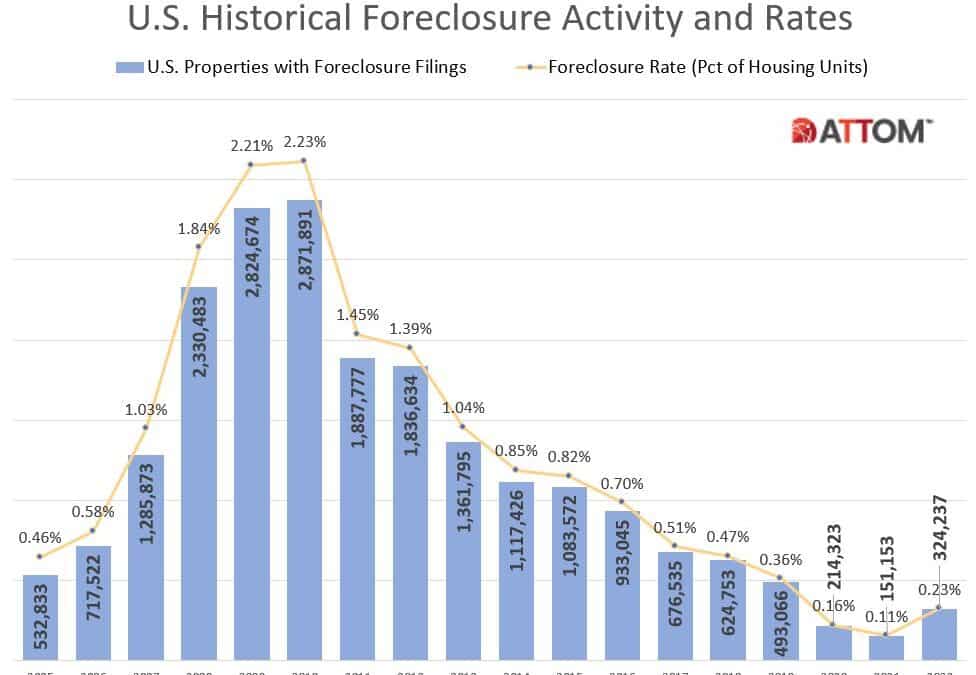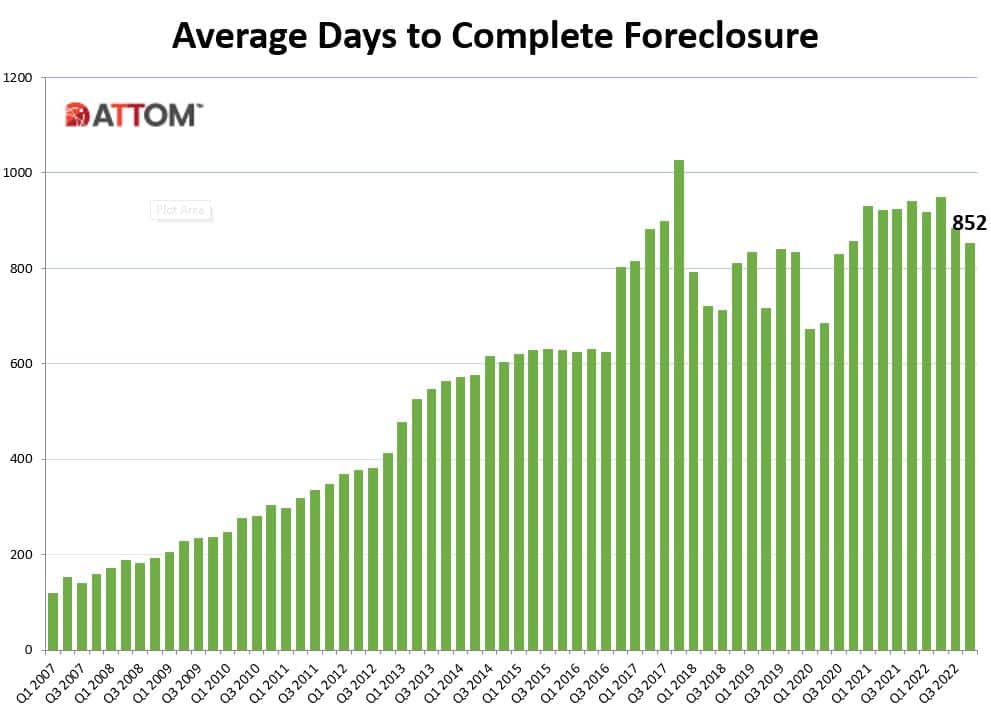Foreclosure Starts Up from 2021, While Foreclosure Completions Decline; Illinois, New Jersey and Delaware Post Highest Foreclosure Rates in 2022
IRVINE, Calif. – Jan. 12, 2023 — ATTOM, a leading curator of real estate data nationwide for land and property data, today released its Year-End 2022 U.S. Foreclosure Market Report, which shows foreclosure activity— default notices, scheduled auctions and bank repossessions — were reported on 324,237 U.S. properties in 2022, up 115 percent from 2021 but down 34 percent from 2019, before the pandemic shook up the market. Foreclosure filings in 2022 were also down 89 percent from a peak of nearly 2.9 million in 2010.
Those 324,237 properties with foreclosure filings in 2022 represented 0.23 percent of all U.S. housing units, up slightly from 0.11 percent in 2021, but down from 0.36 percent in 2019 and down from a peak of 2.23 percent in 2010.
“Eighteen months after the end of the government’s foreclosure moratorium, and with less than five percent of the 8.4 million borrowers who entered the CARES Act forbearance program remaining, foreclosure activity remains significantly lower than it was prior to the COVID-19 pandemic,” said Rick Sharga, executive vice president of market intelligence at ATTOM. “It seems clear that government and mortgage industry efforts during the pandemic, coupled with a strong economy, have helped prevent millions of unnecessary foreclosures.”
ATTOM’s year-end foreclosure report provides a unique count of properties with a foreclosure filing during the year based on publicly recorded and published foreclosure filings collected in more than 3,000 counties nationwide, accounting for more than 99 percent of the U.S. population – also available for license or customized reporting. See full methodology below.
The report also includes new data for December 2022, showing there were 30,822 U.S. properties with foreclosure filings, up less than 1 percent from the previous month but up 72 percent from a year ago.
Bank repossessions decrease 70 percent since 2019
Lenders repossessed 42,854 properties through foreclosures (REO) in 2022, up 67 percent from 2021 but down 70 percent from 2019 (143,955) and down 96 percent from a peak of 1,050,500 in 2010.
States that saw the greatest number of REOs in 2022 included Illinois (5,518 REOs); Michigan (3,669 REOs); Pennsylvania (2,741 REOs); New York (2,405 REOs); and California (2,223 REOs).
Those metropolitan statistical areas with a population greater than 1 million that saw the greatest number of REOs in 2022 included Chicago, Illinois (3,545 REOs); Detroit, Illinois (2,135 REOs); New York, New York (1,656 REOs); St. Louis, Missouri (1,395 REOs); and Philadelphia, Pennsylvania (1,302 REOs).
“Unlike foreclosure activity during the Great Recession, the majority of homes in foreclosure are not being repossessed by lenders,” Sharga noted. “Our recent homeowner equity report shows that 93 percent of borrowers in foreclosure today have positive equity, which they appear to be leveraging in order to avoid a foreclosure by refinancing their mortgage or selling the property at a profit. It seems likely that this is a trend that will continue in 2023.”
Foreclosure starts on the rise nationwide
Lenders started the foreclosure process on 248,170 U.S. properties in 2022, up 169 percent from 2021 but down 26 percent form 2019 and down 88 percent from a peak of 2,139,005 in 2009.
States that saw the greatest number of foreclosure starts in 2022 included California (27,269 foreclosure starts); Texas (23,151 foreclosure starts); Florida (22,968 foreclosure starts); Illinois (16,941 foreclosure starts); and Ohio (13,469 foreclosure starts);
Counter to the national trend, 5 states saw an increase in foreclosure starts from 2019. They included Indiana (up 81 percent); Michigan (up 10 percent); Idaho (up 8 percent); Colorado (up 2 percent); and Minnesota (up less than 1 percent).
Those metropolitan statistical areas with a population greater than 1 million that saw the greatest number of foreclosure starts in 2022, included New York, New York (15,821 foreclosure starts); Chicago, Illinois (14,360 foreclosure starts); Los Angeles, California (8,185 foreclosure starts); Philadelphia, Pennsylvania (7,286 foreclosure starts); and Miami, Florida (7,090 foreclosure starts).
Illinois, New Jersey and Delaware post highest state foreclosure rates in 2022
States with the highest foreclosure rates in 2022 were Illinois (0.49 percent of housing units with a foreclosure filing); New Jersey (0.45 percent); Delaware (0.40 percent); Ohio (0.38 percent); and South Carolina (0.37 percent).
Rounding out the top 10 states with the highest foreclosure rates in 2022, were Nevada (0.34 percent); Florida (0.33 percent); Indiana (0.30 percent); Maryland (0.27 percent); and Michigan (0.26 percent).
Cleveland, Jacksonville, and Atlantic City post highest metro foreclosure rates in 2022
Among 223 metropolitan statistical areas with a population of at least 200,000, those with the highest foreclosure rates in 2022 were Cleveland, Ohio (0.70 percent of housing units with a foreclosure filing); Jacksonville, North Carolina (0.58 percent); Atlantic City, New Jersey (0.58 percent); Columbia, South Carolina (0.55 percent); and Chicago, Illinois (0.53 percent).
Metro areas with a population greater than 1 million, including Cleveland, Ohio and Chicago, Illinois, that had the highest foreclosure rates in 2022, were, Philadelphia, Pennsylvania (0.43 percent); Las Vegas, Nevada (0.42 percent); and Jacksonville, Florida (0.42 percent).
Average time to foreclose decreases quarterly and annually
U.S. properties foreclosed in the fourth quarter of 2022 had been in the foreclosure process an average of 852 days, a 4 percent decrease from the previous quarter and 9 percent decrease from a year ago.
States with the longest average time to foreclose in Q4 2022 were Hawaii (2,546 days); New Jersey (2,041 days); Louisiana (1,925 days); New York (1,828 days); and Pennsylvania (1,692 days).
Q4 2022 Foreclosure Activity High-Level Takeaways
- There was a total of 90,715 U.S. properties with foreclosure filings in Q4 2022, down 2 percent from the previous quarter but up 61 percent from a year ago.
- Nationwide in Q4 2022, one in every 1,549 properties had a foreclosure filing.
- States with the highest foreclosure rates in Q4 2022 were Illinois (one in every 724 housing units with a foreclosure filing); Delaware (one in every 848 housing units); New Jersey (one in every 860 housing units); South Carolina (one in every 950 housing units); and Ohio (one in every 1,035 housing units).
December 2022 Foreclosure Activity High-Level Takeaways
- Nationwide in December 2022, one in every 4,558 properties had a foreclosure filing.
- States with the highest foreclosure rates in December 2022 were South Carolina (one in every 2,301 housing units with a foreclosure filing); New Jersey (one in every 2,378 housing units); Illinois (one in every 2,399 housing units); Delaware (one in every 2,535 housing units); and Ohio (one in every 3,027 housing units).
- 21,023 U.S. properties started the foreclosure process in December 2022, up 2 percent from the previous month and up 129 percent from a year ago.
- Lenders completed the foreclosure process on 3,663 U.S. properties in December 2022, down 3 percent from the previous month but up 21 percent from a year ago.
Report methodology
The ATTOM U.S. Foreclosure Market Report provides a count of the total number of properties with at least one foreclosure filing entered into the ATTOM Data Warehouse during the month and quarter. Some foreclosure data entered into the database during the quarter may have been recorded in the previous quarter. Data is collected from more than 3,000 counties nationwide, and those counties account for more than 99 percent of the U.S. population. ATTOM’s report incorporates documents filed in all three phases of foreclosure: Default — Notice of Default (NOD) and Lis Pendens (LIS); Auction — Notice of Trustee Sale and Notice of Foreclosure Sale (NTS and NFS); and Real Estate Owned, or REO properties (that have been foreclosed on and repurchased by a bank). For the annual, midyear and quarterly reports, if more than one type of foreclosure document is received for a property during the timeframe, only the most recent filing is counted in the report. The annual, midyear, quarterly and monthly reports all check if the same type of document was filed against a property previously. If so, and if that previous filing occurred within the estimated foreclosure timeframe for the state where the property is located, the report does not count the property in the current year, quarter or month.
About ATTOM
ATTOM provides premium property data to power products that improve transparency, innovation, efficiency and disruption in a data-driven economy. ATTOM multi-sources property tax, deed, mortgage, foreclosure, environmental risk, natural hazard, and neighborhood data for more than 155 million U.S. residential and commercial properties covering 99 percent of the nation’s population. A rigorous data management process involving more than 20 steps validates, standardizes, and enhances the real estate data collected by ATTOM, assigning each property record with a persistent, unique ID — the ATTOM ID. The 30TB ATTOM Data Warehouse fuels innovation in many industries including mortgage, real estate, insurance, marketing, government and more through flexible data delivery solutions that include bulk file licenses, property data APIs, real estate market trends, property navigator and more. Also, introducing our newest innovative solution, that offers immediate access and streamlines data management – ATTOM Cloud.
Media Contact:
Christine Stricker
949.748.8428
christine.stricker@attomdata.com
Data and Report Licensing:
949.502.8313








